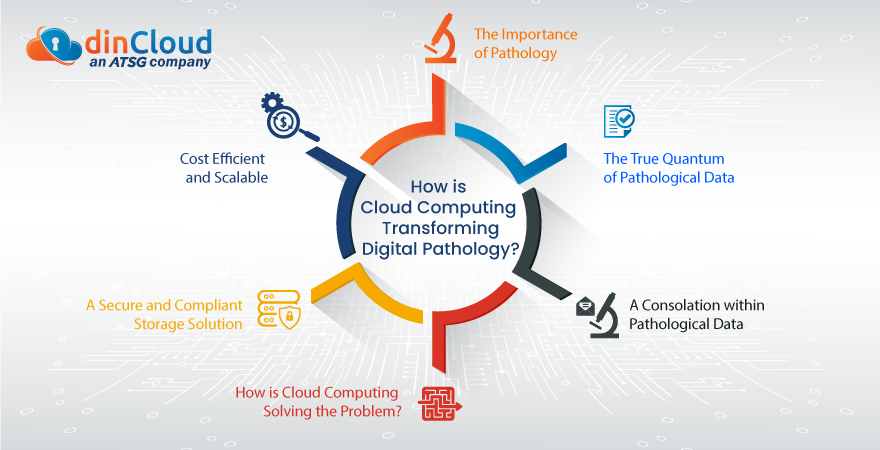Over the past decades, medical science has progressed by leaps and bounds. Digital technologies like Cloud Computing have played an instrumental role in making healthcare more affordable and accessible for the masses.
Within the field of medicine, Pathology is the one area which produces by far the largest amounts of digital imaging data as compared to other disciplines. This has been a major pain point for healthcare providers across the globe.

The Importance of Pathology
Pathology has really revolutionized medicine, especially when it comes to understanding the root causes of diseases, and their course of treatment. Pathology plays a decisive role in determining how a patient will be treated for a cure, or for managing chronic symptoms.
Within itself, Pathology is a vast field, as it can involve the study of body fluids, tissues, surgically removed organs and even the autopsies of the deceased. This area reveals invaluable insights about both a patient and how a disease has been progressing.
All this investment in medical imaging and diagnostic equipment that Pathology needs is not in vain. The insights medical practitioners get from clinical pathology go a long way in treating both patients and the underlying symptoms of chronic diseases.
Related: What New Research Tells Us about Digital Strategy in Higher Ed
The True Quantum of Pathological Data
In order to truly grasp the quantum of this problem, let us put into perspective how much data does Pathology actually produce, especially when compared to the other disciplines within clinical medicine?
The typical X-Ray image of a patient can comprise almost 35 Megabytes of data. If we move slightly higher in the chain, there are CT-Scan images, which can touch almost 300 Megabytes per patient and scan. Though high, these are still quite manageable.
With Pathological data, however, the sheer quantum of the data produced is overwhelming. It is estimated that over the past 10 years, some of the advanced digital diagnostic initiatives have produced half a petabyte of radiology data.
To put things into perspective, this translates into half a million Gigabytes of data, which is too overwhelming and expensive even for the highly established on-premise storage solutions healthcare providers might have.
The above figure relates only to the digital images produced from the biopsies of patients. If we talk of the whole area of Pathology being digitalized, it is estimated that this will result in digital images that can span 3 Petabytes of data per year.
Related: Quarterly Roundup: Healthcare Industry Digital Technology Resources
As a more relatable reference point, 3 Petabytes of data is the equivalent of 3,000 Terabytes or 3 Million Gigabytes of data each year. If we extrapolate this one example to the whole global healthcare sector, the quantum of the problem is quite big.
A Consolation within Pathological Data
When it comes to Pathological data, things are not that bad in the mid to long-term horizon. The good news about pathological digital images is that they tend to lose their clinical relevance from a historical standpoint.
For instance, once a course of treatment has been defined, in the light of digital images, the pathological data is not required for back referencing. This is the consolation within this data-intensive discipline, as it allows permanently deleting the data once it’s used.
In the odd chance that a digital image is required for referencing back, most healthcare providers are finding it more practical and cost-effective to keep a hard copy of a high-quality digital image and archive it for imminent use in the future.
High-definition pathological images have solved the issue of image degradation over time, as it could mislead healthcare providers regarding the historical progression of a disease. This issue has been overcome by keeping high-definition images in complex form.
Related: The Ingredients of a Fruitful Digital Transformation
How is Cloud Computing Solving the Problem?
Now that we have addressed the issue of storing pathological digital images over the long term, the question still remains around their storage in the short to mid-term, when the treatment of a patient is still ongoing.
Secondly, analyzing the Pathological images of a large pool of patients can also reveal invaluable insights into the possible causes, and how to mitigate or preempt those causes in other patients with similar chronic diseases.
A Secure and Compliant Storage Solution
These are two areas where Cloud Computing is really playing an instrumental role. Firstly, Cloud Data Centers act as a safe and cost-efficient repository for the Pathological images/data of patients whose treatment is still in progress.
The robust and resilient cyber security posture of leading Cloud Service Providers (CSP) like dinCloud gives healthcare providers unrivalled peace of mind when they store it within cloud data centres. Then, there is also compliance-related concerns with medical data.
The data centres of leading CSPs like dinCloud to comply with HIPAA, ISO 27001, NIST 800-53/FI, PCI DSS, SOC Type I and II, SS 507, SS 564 and TVRA. These are some of the best international standards for the security and privacy of sensitive data like medical records.
Cost Efficient and Scalable
Healthcare providers seldom have additional financial resources to expend on in-house storage. Their limited IT teams are really overstretched and cannot manage the extra burden of managing patients’ pathological records on-premise.
The Cloud offers a cost-efficient and instantly scalable mode of storing the digital pathological records of patients. Healthcare providers can use the Cloud’s “pay as you use” model and avail phenomenal cost savings.
Related: How to Navigate Digital Transformation in the Year 2022?
Conclusion
The Cloud is not only proving to be a secure, cost-efficient and scalable solution for digital pathological records, but its immense processing muscle is enabling healthcare providers to extract valuable insights from patient data.
Contact dinCloud, an ATSG company, for secure, reliable, scalable and compliant healthcare data storage and processing solutions.


